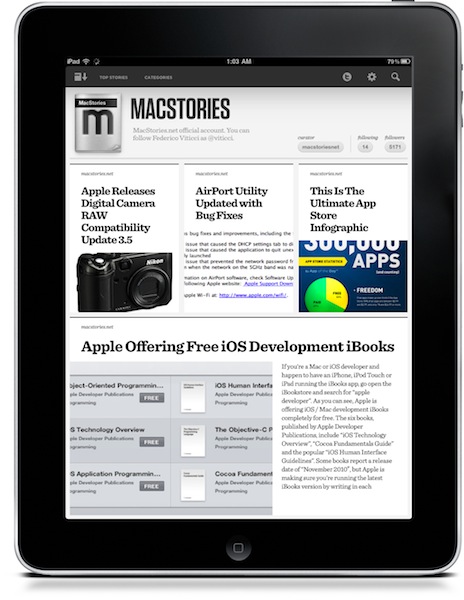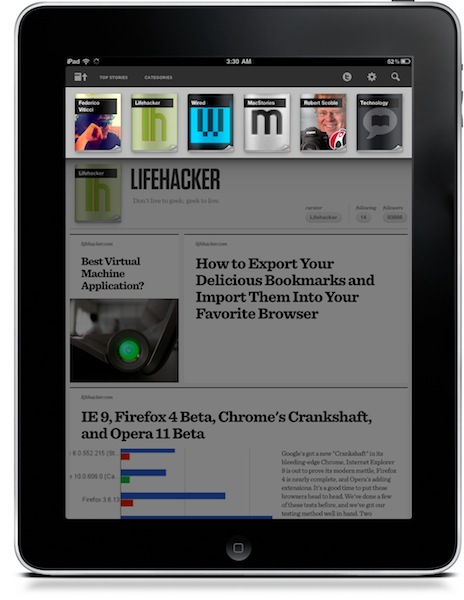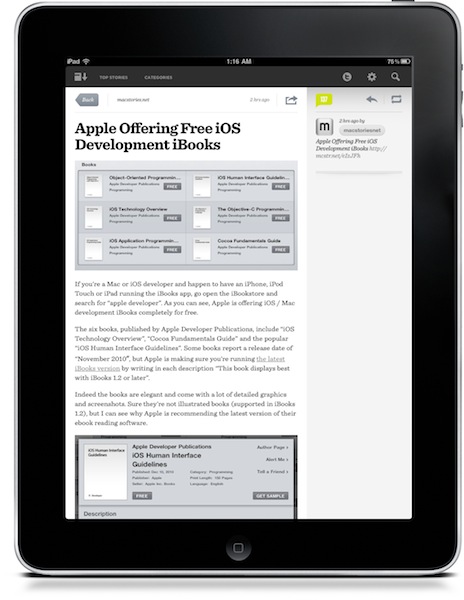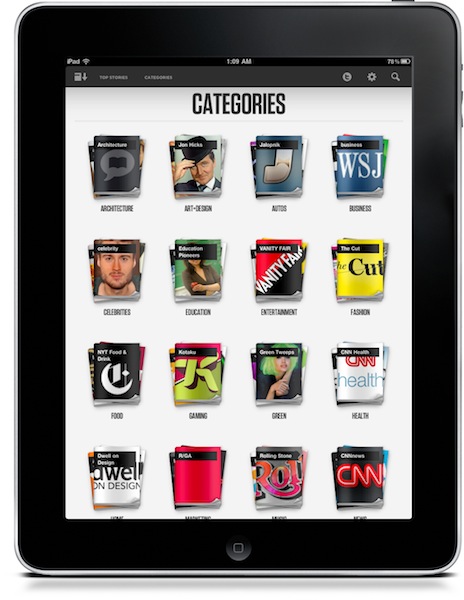TweetMag is, without a doubt, the most beautiful Twitter app that ever landed on the iPad. Yes, TweetMag is more attractive than Flipboard. But they are two different apps. And there’s no way I’m going to focus this review on a comparison between them.
Let me get this out quickly before I dive deeper into this piece of software that appeared on the App Store tonight: Flipboard and Tweetmag are two different products. Both in the intentions, and realization. Yes, they both aim at letting you build a”digital magazine” out of links shared on Twitter. Yes, they share some aspects of a same concept. And yes, they can live together. This is not about which app is going to kill Flipboard, the iPad app of the year. This is not a piece about the functionalities that you’ll find in both the apps, either. This is about TweetMag, a product of its own that aims at providing a new Twitter experience.
You notice how the most used words until now have been “difference”, “experience”, “product”. TweetMag and Flipboard have a lot in common, yet some aspects underlying the overall concept manage to put them on two separate roads. That’s why I’m running both of them on my iPad.
TweetMag ($4.99 in the App Store) wants you to build magazines out of Twitter. No Facebook, Google Reader, or Flickr. TweetMag is for Twitter, it’s build around it and shares its downsides with it. With the combination of a few clever server-side tricks, some magic infused by the developers and, allow me to say it, a gorgeous user interface that’s perfectly wrapped around the iPad, TweetMag provides the most beautiful way of reading Twitter I’ve seen on the iPad so far.
TweetMag revolves around a simple idea: every user, list or search can become a tweetmag. Instead of allowing you to select the people you follow and tell the app “hey, let’s make a magazine out of this stream”, TweetMag is capable of converting almost any kind of Twitter stream into an app-optimized digital magazine. A tweetmag stands out because of its attention to typography, great use of whitespace, elegant layout and the way it (magically) displays content by relevance. But this may be something you won’t notice at first.
When you launch the app for the first time, you’re asked to log in with your Twitter credentials (no multiple accounts support, but there’s really no need to have that) and set a few options to adjust the behavior of the app. TweetMag offers you the possibility to activate what the developers call “give and take computing” (which I guess is a fancy name for the cloud-based infrastructure that runs in the background and distributes resources across TweetMag users – let’s no get too technical) and clean page layouts. The latter one is in my opinion far more important as it’s where TweetMag will expose all its potential. The app pulls links from Twitter and generates magazine layouts; magazine layouts are, of course, made of headlines and sections. As you tap on a headline, you’d expect to see something. Now, TweetMag lets you choose between two ways for that something: either you jump to a standard web view, or you let the app do its job and pull text from web pages, clean it up, format it for the iPad and display it in a neatly organized magazine layout. I definitely went for the clean page layout setting.
By default, TweetMag creates a magazine for your Twitter account. You can’t delete or edit this mag. The app will grab links from your timeline and that’s it. These links, though, aren’t displayed with the actual Twitter message as headline – TweetMag also pulls the article headline (or webpage title) from the web and places it in the magazine. The first image of a blog post or webpage will also find its way to the tweetmag, together with iPad-compatible videos, if any. To sum up: TweetMag uses Twitter, only to build magazines with content coming from the web. Content is shared on Twitter, so that must have sounded like the most logical step to the developers.
A tweetmag isn’t something abstract or invisible we’re mentioning to indicate the functionality of the app. TweetMag has actual digital magazines in its UI, which you can create and save at any time in a “shelf” that sits at the top of the window and you can invoke with a simple pull-down gesture. It works like this: you’re going through your Twitter timeline and you see @codyfink has been tweeting lots of cool stuff recently. You tap on his profile picture, the app refreshes and provides a view of Cody’s timeline. You tap & hold on his tweetmag icon, you drag the magazine to the shelf and boom – you just saved a tweetmag for Cody’s timeline. It’s that simple. This applies to @usernames, #trends, searches, lists – anything. The app also features a search button in its upper left corner that reminds you can create mags out of anything at any given time. If it’s on Twitter, it can become a tweetmag.
TweetMag doesn’t want you to do all user discovery and magazine creation by yourself, though, that’s why the developers implemented two features to make it easy for anyone to have a dozen of mags up and running (or should I say, readable) in a matter of minutes after launch. There is a “Top Stories” section in the top toolbar that’s basically a magazine for popular links on Twitter (again, I guess this is generated by TweetMag’s “invisible” cloud system) and a Categories tab which is simply great. The Categories tab is not a magazine – rather, it contains sub-sections that grant you access to dozens of built-in magazines created out of lists and users. There’s a Technology section, for example, which features lists curated by the TweetMag staff (its own “Tech” list) and other popular Twitter lists such as Robert Scoble’s ones. In the same Technology section, there are some recommended users, too. All of these tweetmags can be dragged to the top shelf to be read at any time.
What I like about TweetMag is that it doesn’t bother you with unread badges, notifications and reminders. It just finds links and builds a beautiful experience around them. There’s not really much to say about the core of the app, the magazine: it’s clean and it looks great. When scrolling through a tweetmag you’ll notice that it’s possible to double-tap on headline to reveal a box containing the original Twitter message, a retweet count, and buttons to reply and retweet. I like it because it allows me to see who’s behind a link, it gives a human feeling to this whole digital magazine thing. But what about actual reading? That’s pretty simple and minimal, too. You tap on a link, the mag slides off to reveal the full text in a clean page. This page only has a sidebar on the right that shows tweets containing the original link. You can retweet, reply to the author and jump to the web view if you don’t feel like reading through TweetMag’s article view – but you can’t mark a tweet as favorite. That’s one of my major gripes with the app as it forces me to either email myself a tweet, save it to Instapaper or retweet it if I want to keep it for later. I’m told a favorite button will find its way in a new version of TweetMag next year. I still think it should have been there in the first version.
As intriguing as it sounds, TweetMag isn’t perfect. I have experienced a few crashes when trying to load usernames and I have noticed some headlines being weirdly cut off by the app. I guess this must be one of the downside of using a cloud backend to render Twitter contents pushing them to the app? I don’t know. Thing is, TweetMag feels pretty slow at loading Twitter sometimes and scrolling isn’t as smooth as you would expect from an iPad app. Then again, an updated version is coming out soon and I’m pretty confident these initial issues will be fixed in that release.
Back to the first paragraphs of this review: what’s the road TweetMag has taken? Where does it go from here? I think TweetMag and Flipboard can co-exist in the current iPad panorama. While Flipboard aims at delivering the world’s first social magazine, TweetMag offers you the chance to create a collection of magazines specifically meant for Twitter. That’s a subtle difference, I know – but the approaches of the developers make all the difference in this world.
TweetMag is beautiful. Just take a look at the screenshots and the promo video. There’s no need to discuss the pixels here. TweetMag allows me to have a better Twitter reading experience by providing the tools to enjoy an uncluttered view of the noise that’s often shared online. It’s got a few bugs and a couple of missing functionalities, but the product on the whole feels solid. It is a solid app, one hell of a first release.
So when I’m asked “How does it compare to Flipboard” I say “I don’t know”, because of one thing I’m sure: apps like TweetMag and Flipboard can’t be trimmed down to a “yes” or “no”. We have discussed the graphics and the features, the issues and what needs to get better soon – but in the end I’m just going to say “try it”. Of this I’m sure: TweetMag needs to be experienced.
Because it’s worth it.






